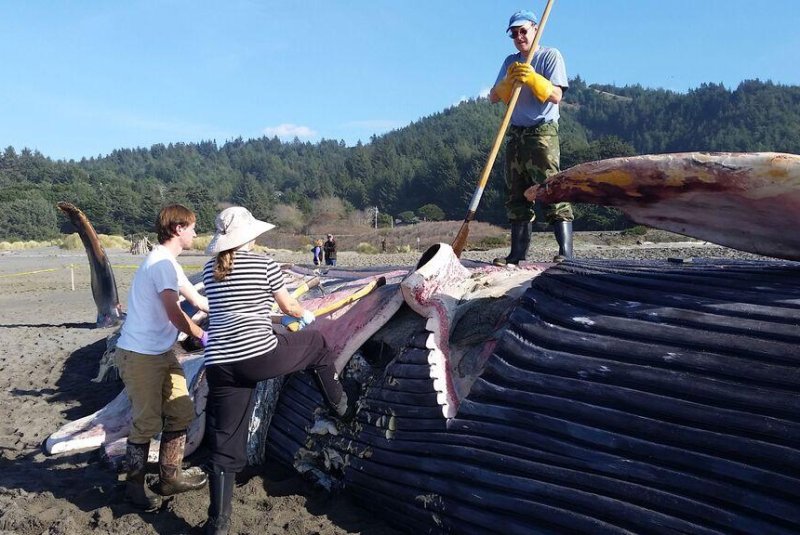Scientists and volunteers began working to strip away the blubber from the beached blue whale last week. The blue whale's skeleton will be put on display at a local museum. Photo by the Oregon Parks and Recreation Department
GOLD BEACH, Ore., Nov. 10 (UPI) -- Oregon State University's Marine Mammal Institute is set to get its hands on its first local blue whale samples in more than a century.
Baleen from a beached blue whale's mouth is being transported to the institute for research purposes. Part of the skeleton has been extracted and is on its way to Hatfield Marine Science Center. Curators there expect to have it on display by 2018.
"They've removed about 19 feet of the vertebrae," said Chris Havel, associate director of the Oregon Parks and Recreation Department.
On Tuesday, volunteers and biologists remained hard at work extracting bones and burying decomposing blubber. It's a job they don't have all that much practice at, as blue whales are rare along the Oregon Coast.
Blue whale carcass washes ashore in OregonAn uncommon beach find in Oregon, this 78-foot, 100-plus ton, blue whale has washed ashore in Curry County approximately 10 miles north of Gold Beach. The OSU Marine Mammal Institute in Newport is working on a plan to recover the skeletal parts. Ten university students are removing the blubber and insides.
Posted by Oregon State Parks on Friday, November 6, 2015
"We don't usually see blue whales this close in," Calum Stevenson, a scientist and ocean shores specialist with the state's parks department, told the Register Guard. "They are not even on our radar for Whale Watch because they are so uncommon."
The whale was found on Oregon's Gold Beach last week, already dead and textured with the bite marks of sharks and killer whales. The specimen weighed 100 tons and stretched 78 feet long.
The whale's deconstruction is expected take several more days. After the blubber was stripped, meat and muscle had to be cut away. On Monday, machinery was used to lift some of the heavier bones.
Havel says researchers are having trouble removing the whale's skull, as the head muscles are tough to strip away.
Some blubber is buried deep in the sand, where it can decompose. Some of it is being burned. Researchers say the blubber wasn't as thick as one would find on a healthy blue whale. The specimen was likely sick or starving before being attacked by predators and killed.
The job of breaking down the whale was physically demanding -- and smelly.
"You can definitely smell it even from the freeway when you're coming down the 101," local resident Dawn Vandort told KCBY. "It's -- indescribable."
Smell or not, the whale's presence is exciting for many.
"Messy, smelly -- but I study humpback whales, so for me it's sort of neat to see," said Logan Pallin, an OSU graduate student. "I've never seen a blue whale, so it's pretty spectacular."















